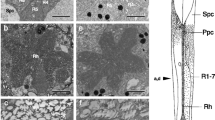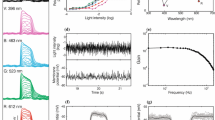Summary
The compound eye of the fly Musca domestica L. contains two receptor-systems, separable by their anatomical and physiological properties (Kirschfeld and Franceschini, 1968; Kirschfeld and Reichardt, 1970; Eckert, 1971). By means of optomotor experiments the spectral characteristics of the receptor-system 1–6 (“green receptor”) and the receptor-system 7 + 8 (“blue receptor”) have been determined separately in the range of 300–600 mμ.
The torque exerted by fixed flying Muscae was used as a measure of the optomotor reaction elicited by the rotation of cylindrical patterns with periodically changing surface reflectance. The receptor-system 1–6 is specifically stimulated under very dim illumination and by applying a pattern wavelength of 10,6° whereas the receptor-system 7 + 8 is specifically stimulated by making use of a pattern of 3° spatial wavelength illuminated with higher light intensities. In order to determine the spectral sensitivity distributions of the two receptor-systems the dependence of the reaction on the wavelength of monochromatic light was measured at threshold intensities.
The following experimental results were obtained:
-
1.
The spectral sensitivity distribution of the receptor-system 1–6 shows two sensitivity maxima, one at λ max≅360 mμ and the other at 486,0+2.4 mμ. A minimum is found at λmax≅400 mμ. The maximum within the ultraviolet spectrum is equal to or even larger than that within the visible region.
-
2.
The spectral sensitivity distribution of the receptor-system 7 + 8 has only one maximum at λ max=464,0 +2.5 mμ. No maximum is found in the ultraviolet spectrum.
-
3.
The difference of the maxima obtained for the two systems within the visible region is statistically significant (Student-t-Test; p<0.001). The existence of a “reverse” Purkinje-shift is therefore confirmed.
-
4.
These types of experiments cannot indicate the existence of dissimilar visual pigments in the two receptor types.
-
5.
The possibility of bichromatic colour vision by the fly (at the light levels studied) is made feasible by the dissimilar spectral characteristics of the two receptor-systems.
Similar content being viewed by others
Literatur
Autrum, H., Burkhardt, W.: Die spektrale Empfindlichkeit einzelner Sehzellen. Naturwissenschaften 22, 527 (1960).
—, Kolb, G.: Spektrale Empfindlichkeit einzelner Sehzellen der Aeschniden. Z. vergl. Physiol. 60, 450–477 (1968).
—, Stumpf, H.: Elektrophysiologische Untersuchungen über das Farbensehen von Calliphora. Z. vergl. Physiol. 35, 71–104 (1953).
—, v. Zwehl, V.: Zur spektralen Empfindlichkeit einzelner Sehzellen der Drohne (Apis mellifica º). Z. vergl. Physiol. 46, 8–12 (1962).
—: Die spektrale Empfindlichkeit einzelner Sehzellen des Bienenauges. Z. vergl. Physiol. 48, 357–384 (1964).
Bennett, R., Tunstall, J., Horridge, G.: Spectral sensitivity of single retinula cells of the locust. Z. vergl. Physiol. 55, 195–206 (1967).
Briggs, M.: Retinene-1 in insect tissues. Nature (Lond.) 192, 874–875 (1961).
Bruckmoser, P.: Die spektrale Empfindlichkeit einzelner Sehzellen des Rückenschwimmers Notonecta glauca L. (Heteroptera). Z. vergl. Physiol. 59, 187–204 (1968).
Buddenbrock, W. v., Friedrich, H.: Neue Beobachtungen über die kompensatorischen Augenbewegungen und den Farbensinn der Taschenkrabben (Carcinus maenas). Z. vergl. Physiol. 19, 747–761 (1933).
Burkhardt, D.: Spectral sensitivity and other response characteristics of single visual cells in the arthropod eye. Symp. Soc. exp. Biol. 16, 86–109 (1962).
—, Colour discrimination in insects. Advances in Insect Physiol. 2, 131–173 (1964).
—, Autrum, H.: Die Belichtungspotentiale einzelner Sehzellen von Calliphora erythrocephala. Z. Naturforsch. 15b, 612–616(1960).
Dartnall, H. J. A.: The interpretation of spectral sensitivity curves. Brit. med. Bull. 9, 24–30 (1953).
Daumer, K.: Reizmetrische Untersuchungen des Farbensehens der Bienen. Z. vergl. Physiol. 38, 413–478 (1956).
Eckert, H.: Optomotorische Untersuchungen am visuellen System der Stubenfliege Musca domestica L. (Bestimmung des optischen Auflösungsvermögens, der Kontrastempfindlichkeit und der Lichtflüsse in den Receptoren der Komplexaugen in Abhängigkeit vom Adaptationszustand). Kybernetik (1971) in Vorbereitung.
Eckert, H., Reichardt, W.: Eine Interpretation des Zusammenhanges zwischen dem Musterkontrast und der mittleren Leuchtdichte bei optomotorischen Schwellenreaktionen (Verhaltensexperimente an der Stubenfliege Musca). Kybernetik (1971) in Vorbereitung.
Fermi, G., Reichardt, W.: Optomotorische Reaktionen der Fliege Musca domestica (Abhängigkeit der Reaktion von der Wellenlänge, der Geschwindigkeit, dem Kontrast und der mittleren Leuchtdichte bewegter periodischer Muster). Kybernetik 2, 15–28 (1963).
Fingerman, M., Brown, F., Jr.: A “Purkinje-shift” in insect vision. Science 116, 171–172 (1952).
Franceschini, N., Kirschfeld, K.: Etude optique in vivo des éléments photorécepteurs dans l'oeil composé de Drosophila. Kybernetik 8, 1–13 (1971).
Frisch, K. v.: Farbensinn und Formensinn der Biene. Zool. Jb. Abt. allg. Zool. u. Physiol. 35, 1–182 (1914).
Gogala, M.: Die spektrale Empfindlichkeit der Doppelaugen von Ascalaphus macaronius Scop. (Neuroptera, Ascalaphidae). Z. vergl. Physiol. 57, 232–243 (1967).
—, Hamdorf, K., Schwemmer, J.: UV-Sehfarbstoff bei Insekten. Z. vergl. Physiol. 70, 410–413 (1970).
Goldsmith, T. H.: In: Light and life (W.D. McElroy and B. Glass, eds.), p. 771–794. Baltimore: Johns Hopkins Press 1961.
—, Dizon, A., Fernández, H.: Microspectrophotometry of photoreceptor organelles from eyes of the Prawn Palaemonetes. Science 161, 468–469 (1968).
—, Fernández, H.: Comparative studies of crustacean spectral sensitivity. Z. vergl. Physiol. 60, 156–175 (1968).
Götz, K. G.: Optomotorische Untersuchung des visuellen Systems einiger Augenmutanten der Fruchtfliege Drosophila. Kybernetik 2, 77–92 (1964).
Graham, C. H., Hartline, H. K.: The response of single visual sense cells to lights of different wavelengths. J. gen. Physiol. 18, 917–931 (1935).
Hamdorf, K., Langer, H.: Veränderung der Lichtabsorption im Facettenauge bei Belichtung. Z. vergl. Physiol. 51, 172–184 (1966).
Hamilton, W. F.: A direct method of testing colour vision in lower animals. Proc. nat. Acad. Sci. (Wash.) 8, 350–353 (1922).
Hasselmann, E. M.: Über die spektrale Empfindlichkeit von Käfer- und Schmetterlingsaugen bei verschiedenen Helligkeiten. Zool. Jb., Abt. allg. Zool. u. Physiol. 69, 537–576 (1962).
Hays, D., Goldsmith, T. H.: Microspectrophotometry of the visual pigment of the spider crab Libinia emarginata. Z. vergl. Physiol. 65, 218–232 (1969).
Hess, C.: Neues zur Frage nach einem Farbensinn bei Bienen. Naturwissenschaften 8, 927–929 (1920).
Hoffmann, C., Langer, H.: Die spektrale Augenempfindlichkeit der Mutante „chalky” von Calliphora erathrocephala. Naturwissenschaften 48, 605 (1961).
Horridge, G.: Perception of polarization plane, colour and movement in two dimensions by the Crab Carcinus. Z. vergl. Physiol. 55, 207–224 (1967).
Ilse, D.: Über den Farbensinn der Tagfalter. Z. vergl. Physiol. 8, 658–692 (1928).
—: Über das Sehen der Insekten, besonders der Tagfalter. S.B. Ges. Naturf. Fr. Berlin. 1/3, 1–16 (1934).
—: New observations on responses to colours in egglaying butterflies. Nature (Lond.) 140, 544–545 (1937).
—: Colour discrimination in the dronefly Eristalis tenax. Nature (Lond.) 163, 255–256 (1949).
Kaiser, W.: Zur Frage des Unterscheidungsvermögens für Spektralfarben: Eine Untersuchung der Optomotorik der königlichen Glanzfliege Phormia regina Meig. Z. vergl. Physiol. 61, 71–102 (1968).
Kay, R. E.: Fluorescent materials in insect eyes and their possible relationship to ultra-violet sensitivity. J. Insect Physiol. 15, 2021–2038 (1969).
Kirschfeld, K.: Absorption properties of photopigments in single rods, cones and rhabdomeres. In: Processing of optical data by organisms and by machines (ed. W. Reichardt). Proc. of the Int. School of Physics “Enrico Fermi” (1969).
Kirschfeld, K.: Pers. Mitteilung (1970).
—: Franceschini, N.: Optische Eigenschaften der Ommatidien im Komplexauge von Musca. Kybernetik 5, 47–52 (1968).
—, Franceschini, N.: Ein Mechanismus zur Steuerung des Lichtflusses in den Rhabdomeren des Komplexauges von Musca. Kybernetik 6, 13–22 (1969).
—, Reichardt, W.: Optomotorische Versuche an Musca mit polarisiertem Licht. Z. Naturforsch. 25b, 228 (1970).
Knoll, F.: Insekten und Blumen. Experimentelle Arbeiten zur Vertiefung unserer Kenntnisse über die Wechselbeziehungen zwischen Pflanzen und Tieren. Abh. Zool.-Bot. Ges. Wien, 12, 1–116 (1921).
—: Insekten und Blumen II. Lichtsinn und Blumenbesuch des Falters von Macroglossum stellatarum. Abh. Zool.-Bot. Ges. Wien 12, 123–377 (1922).
—: Lichtsinn und Blütenbesuch des Falters von Deilephia livornica. Z. vergl. Physiol. 2, 329–380 (1925).
Knoll, F.: Über Abendschwärmer und Schwärmerblumen. Ber. dtsch. bot. Ges. 45, 510–518 (1927).
Kunze, P.: Untersuchung des Bewegungssehens fixiert fliegender Bienen. Z. vergl. Physiol. 44, 656–684 (1961).
Langer, H.: Spektrometrische Untersuchungen der Absorptionseigenschaften einzelner Rhabdomere im Facettenauge. Verh. dtsch. zool. Ges. 29, 329–338 (1965a).
—: Nachweis dichroitischer Absorption des Sehfarbstoffes in den Rhabdomeren des Insektenauges. Z. vergl. Physiol. 51, 258–263 (1965b).
—: Grundlagen der Wahrnehmung von Wellenlänge und Schwingungsebene des Lichtes. Verh. dtsch. Zool. Ges. Göttingen, Suppl. 30, 195–233 (1966).
—: Die physiologische Bedeutung der Farbstoffe im Auge der Insekten. Umschau 4, 112–120 (1967).
—, Thorell, B.: Microspectrophotometry of single rhabdomeres in the insect eye. Exp. Cell Res. 41, 633–677 (1966).
Mazokhin-Porshniakov, G. A.: Colorimetric study of the properties of the house-fly. Akad. Nauk SSSR Biofizika 5, 295–303 (1960).
—: System of colour vision of the Fly Calliphora. Akad. Nauk SSSR Biofizika 5, 697–703 (1960).
McCann, G. D.: Pers. Mitteilung (1970).
Moller-Racke, I.: Farbensinn und Farbenblindheit bei Insekten. Zool. Jb., Abt. Allg. Zool. u. Physiol. 63, 237–274 (1952).
Nosaki, H.: Electrophysiological study of color encoding in the compound eye of the crayfish Procambarus clarkii. Z. vergl. Physiol. 64, 318–323 (1969).
Reichardt, W., Braitenberg, V., Weidel, G.: Auslösung von Elementarprozessen durch einzelne Lichtquanten im Fliegenauge. Kybernetik 5, 148–170 (1968).
Schlegtendahl, A.: Beitrag zum Farbensinn der Arthropoden. Z. vergl. Physiol. 20, 545–581 (1934).
Sehlieper, C.: Farbensinn der Tiere und optomotorische Reaktionen. Z. vergl. Physiol. 6, 453–472 (1927).
Schneider, G.: Spektrale Empfindlichkeit des Komplexauges von Calliphora. Z. vergl. Physiol. 39, 1–20 (1956).
Scholes, J.: The electrical response of the retinal receptors and the lamina in the visual system of the Fly Musca. Kybernetik 6, 149–162 (1969).
Stieve, H.: Die spektrale Empfindlichkeitskurve des Auges von Eupagurus bernhardus L. Z. vergl. Physiol. 43, 518–525 (1960).
Strausfeld, N.: (1971). In Vorbereitung.
Waterman, T. H.: Directional sensitivity of single ommatidia in the compound eye of limulus. Proc. nat. Acad. Sci. (Wash.) 40, 252–257 (1954).
—, Fernández, H. R.: E-vector and wavelength-discrimination by retinular cells of the crayfish Procambarus. Z. vergl. Physiol. 68, 154–174 (1970).
—, Goldsmith, T.: Dichroism of photosensitive pigment in rhabdoms of the crayfish Orconectes. J. gen. Physiol. 54, 415 (1969).
Walther, J. B., Dodt, E.: Die Spektralsensitivität von Insektenkomplexaugen im Ultraviolett bis 290 mμ. Z. Naturforsch. 14b, 273–278(1959).
Author information
Authors and Affiliations
Additional information
Für wertvolle Diskussionen danke ich den Herren Professor Dr. W. E. Reichardt, Dr. K. Kirschfeld und N. Franceschini. Den Herren Dr. K. G. Götz und Dipl.-Phys. H. Wenking danke ich für Bat und Hilfe beim Bau der Meßapparatur, Herrn Feinmechanikermeister H. Braun und seinen Mitarbeitern für den Bau des Doppelspulensystems. Für das Fertigstellen der Abbildungen bin ich Herrn E. Freiberg und Fräulein B. Weismann, für das Fertigstellen des Manuskripts Fräulein I. Geiß zu besonderem Dank verpflichtet.
Die Max-Planck-Gesellschaft zur Förderung der Wissenschaften e.V. ermöglichte meine Arbeit am Max-Planck-Institut für biologische Kybernetik durch ein Stipendium.
Rights and permissions
About this article
Cite this article
Eckert, H. Die spektrale Empfindlichkeit des Komplexauges von Musca (Bestimmung aus Messungen der optomotorischen reaktion). Kybernetik 9, 145–156 (1971). https://doi.org/10.1007/BF00290480
Received:
Issue Date:
DOI: https://doi.org/10.1007/BF00290480




